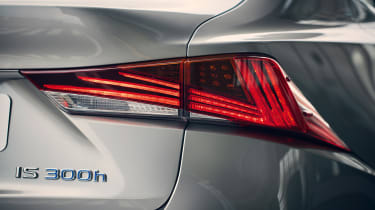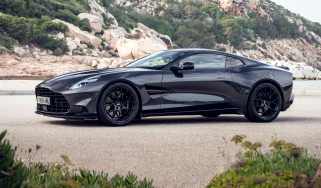Refreshed Lexus IS saloon makes Paris debut
A subtle facelift and improved suspension should give the IS a new lease of life
Lexus has given its IS range of junior saloons a mid-life facelift, and has taken the opportunity to stiffen up the suspension, too.
The third-generation IS, which launched in 2013, has always stood out next to rivals from BMW, Mercedes and Audi, but new headlights, much larger air intakes in the front bumper and some tweaks to the gaping spindle grille (including raising its ‘waist’ to give an impression that the car has a lower centre of gravity, apparently) have been introduced to keep it looking sharp.
Lexus has also reshaped the bonnet and will offer new 17-inch and 18-inch wheel designs, while at the back there are new ‘triple-layered’ LED lights and rectangular, chromed exhaust tips.
Changes to the interior are subtle, though the infotainment screen has increased from seven inches in diameter to 10.25 inches and is now of a higher resolution.
Given the more aggressive exterior design, it’s disappointing that power outputs will remain the same across the range. This is particularly true of the hybrid IS300h (which accounts for nine out of ten IS sales in Europe), which despite combining a naturally aspirated 2.5-litre in-line four with an electric motor, still offers just 179bhp and 163lb ft. The IS200t, meanwhile, is the more exciting package and develops 241bhp and 258lb ft from its turbocharged 2-litre engine.
evo has always considered the suspension setup to be a strong-point of the IS range, and now both models will benefit from new forged-aluminium lower-arm assemblies said to be 49 per cent stiffer than the steel hardware currently in use. Spring rates have also been revised for the front axle and there are upgraded dampers that have been recalibrated.
Whether these changes are primarily to improve B-road handling or motorway cruising isn’t clear, but rear traction, stability, ride quality and body control are all said to be better than before.
Both cars are real-wheel-drive, although the torque-rich turbocharged model benefits from an eight-speed automatic gearbox that makes it more intuitive and enjoyable to drive than the IS300h, which is hindered by its e-CVT. Lexus hasn’t yet said whether the upgraded IS200t in F Sport trim will benefit from the Torsen limited-slip differential of the RC200t F Sport (read our review here), but such an addition to the drivetrain would be no bad thing.
Prices for the new IS range have yet to be announced, but are unlikely to differ much from those for the current IS200t or IS300h, which both start at £28,995.




